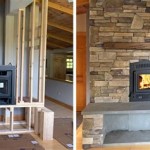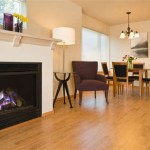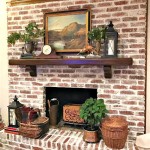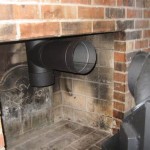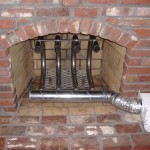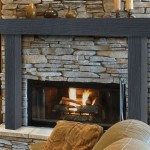Built-In Entertainment Center With Fireplace: A Comprehensive Guide
The integration of a built-in entertainment center with a fireplace represents a significant upgrade to any living space, combining functionality with aesthetic appeal. This design choice serves as a focal point, uniting entertainment and relaxation into a single, cohesive unit. The design considerations, installation processes, and variations available are multifaceted, demanding careful planning and execution.
A built-in entertainment center provides ample storage for media equipment, books, decorative items, and other household necessities, contributing to a more organized and clutter-free environment. The inclusion of a fireplace, whether gas, electric, or traditional wood-burning, adds warmth and ambiance, enhancing the overall comfort and visual appeal of the room. The combination requires a comprehensive understanding of design principles, building codes, safety regulations, and available technologies.
Key Considerations Before Installation
Several crucial factors must be carefully evaluated before embarking on the installation of a built-in entertainment center with a fireplace. Foresight in these areas ensures a successful and satisfying outcome, preventing potential problems and maximizing the benefits of the project.
First and foremost is the structural integrity of the wall on which the unit will be built. Weight distribution is paramount, particularly with larger entertainment centers and heavier fireplace units. A structural engineer or qualified contractor should assess the wall's load-bearing capacity and recommend any necessary reinforcement. This includes verifying the framing is adequate to support the weight of the unit and any additional load from electronic equipment and decorative items. Improper support can lead to sagging, cracking, or even structural failure, posing a safety hazard.
The type of fireplace chosen significantly impacts installation requirements and overall design. Gas fireplaces require gas line connections, which must be installed by a licensed professional following local codes. Electric fireplaces need only a dedicated electrical circuit. Wood-burning fireplaces necessitate a chimney, flue, and proper ventilation, requiring more extensive construction and adherence to strict fire safety regulations. Each type has distinct venting needs, clearances from combustible materials, and maintenance requirements that must be addressed during the planning phase. The choice of fireplace should align with the home's existing infrastructure, budget constraints, and aesthetic preferences.
Lastly, meticulous measurements are critical. Accurate dimensions of the wall space, including height, width, and depth, are essential for designing an entertainment center that fits seamlessly into the room. Consider the placement of existing outlets, light switches, and HVAC vents. These elements may need to be relocated or accommodated within the design. A detailed floor plan, incorporating the proposed entertainment center and fireplace, aids in visualizing the final product and identifying potential conflicts. Professional design software can be invaluable in creating accurate renderings and ensuring optimal space utilization.
Design and Style Options
The design possibilities for a built-in entertainment center with a fireplace are virtually limitless, allowing homeowners to personalize the unit to match their individual tastes and complement the existing décor. From traditional to contemporary styles, the design can be tailored to create a cohesive and visually appealing focal point.
Traditional designs often feature rich wood finishes, intricate moldings, and classic architectural details. These entertainment centers may incorporate features such as raised panel doors, fluted columns, and ornate carvings. The fireplace surround is typically made of marble, granite, or brick, adding to the sense of timeless elegance. Traditional designs often evoke a sense of warmth and formality, creating a cozy and inviting atmosphere. These designs are often best suited for homes with existing traditional architecture and décor.
Contemporary designs, on the other hand, embrace clean lines, minimalist aesthetics, and modern materials. These entertainment centers may feature sleek cabinets with flat-panel doors, glass shelves, and metal accents. The fireplace surround is often made of concrete, tile, or stainless steel, creating a streamlined and sophisticated look. Contemporary designs emphasize functionality and simplicity, creating a sense of spaciousness and openness. These designs are well-suited for homes with modern architecture and décor.
Transitional designs bridge the gap between traditional and contemporary styles, blending elements of both to create a unique and versatile look. These entertainment centers may incorporate features such as shaker-style doors, simple moldings, and a mix of wood and metal finishes. The fireplace surround can be customized to match the overall design, combining materials and textures to create a balanced and harmonious aesthetic. Transitional designs offer a flexible and adaptable approach, allowing homeowners to personalize the unit to their specific preferences. These designs work well in a variety of home styles.
Beyond the overall style, consider the specific storage needs and functionalities desired. Open shelving provides display space for decorative items and books, while closed cabinets conceal media equipment and other clutter. Drawers offer convenient storage for smaller items, such as remotes, DVDs, and gaming accessories. Adjustable shelves allow for flexibility in accommodating various sizes of electronic devices and decorative objects. The design should also incorporate wire management systems to conceal cables and cords, maintaining a clean and organized appearance. Thoughtful planning of storage solutions is essential for maximizing the functionality and usability of the entertainment center.
Installation Process and Safety Considerations
The installation of a built-in entertainment center with a fireplace is a complex undertaking that requires careful planning, precise execution, and adherence to strict safety regulations. Whether opting for professional installation or a do-it-yourself approach, certain guidelines must be followed to ensure a safe and successful outcome.
For gas fireplaces, hiring a licensed and qualified gas fitter is non-negotiable. The gas fitter will be responsible for connecting the fireplace to the gas line, ensuring proper ventilation, and verifying the unit's safe operation. Installing a gas fireplace incorrectly can lead to gas leaks, carbon monoxide poisoning, and fire hazards. All gas line connections must be pressure-tested and inspected to ensure they meet local codes and regulations. Additionally, a carbon monoxide detector should be installed in the vicinity of the fireplace to provide an early warning of any potential leaks.
Electrical work associated with the entertainment center and fireplace, including wiring, outlets, and circuit breakers, should be performed by a licensed electrician. Ensure the electrical system is properly grounded and that all connections are made according to code. Overloading circuits can lead to electrical fires, so it is crucial to have adequate capacity to handle the power requirements of all electronic devices and the fireplace. A dedicated circuit for the fireplace is often recommended. The electrician should also verify that the wiring is properly insulated and protected from heat and moisture.
During the construction process, dust and debris can accumulate, posing a fire hazard. Regularly clean the work area to remove flammable materials. Keep fire extinguishers readily available and ensure they are properly charged. When working with power tools, wear appropriate safety gear, including eye protection, hearing protection, and a dust mask. Follow all manufacturer's instructions and safety guidelines for the tools and equipment being used. If unfamiliar with any aspect of the installation process, consult with a qualified professional. Prioritizing safety throughout the installation process is paramount to preventing accidents and ensuring the long-term safe operation of the entertainment center and fireplace.
Finally, adhering to building codes and regulations is essential. Obtain the necessary permits from the local building department before starting the project. These codes are in place to ensure the safety and structural integrity of the installation. Local building inspectors may require inspections at various stages of the project to verify compliance with the code. Failure to comply with building codes can result in fines, delays, and even the removal of the entertainment center and fireplace. Researching and understanding the applicable codes and regulations are crucial for ensuring a legally compliant and safe installation.

Custom Built In Entertainment Furniture And Cabinets With Electric Fireplaces

Custom Built In Entertainment Furniture And Cabinets With Electric Fireplaces

Built In Entertainment Center And Fireplace Around Ins Living Room

Park Lane Fireplace Entertainment Center With Optional Bookcases

Aubrey Electric Fireplace Media Cabinet Pottery Barn

Custom Built White Wall Unit With Dimplex Electric Fireplace Furniture Design Gallery

Custom Built In Entertainment Furniture And Cabinets With Electric Fireplaces

Modern Tv Wall With Fireplace Iv Yo Carpentry

Faux Stone Fireplace Entertainment Center Genstone

Built In Wall Drywall Entertainment Centers En Fireplace Center Contemporary
Related Posts


